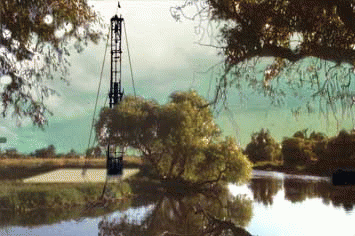After a one-week hiatus, this article emerged from the fifth of 10 planned lectures held by the Center of the American West,
CU Continuing Education, Boulder County, and the AirWaterGas Research Network
(of the National Science Foundation/Sustainability Research Network) on various
aspects of hydraulic fracturing.
Fracking the Poudre River by Photo credit jdial
Honesty is so refreshing.
It was clarifying, if not encouraging, to hear an engineer and
non-politician talk about what we know and what we do not know about fracking
and its effects on our water supplies.
Joe Ryan [1] is pleasant, humorous, and well educated in the unguinous
arts. If there is a fault to an
engineer's approach, it is that the clean knife of reductionism can somewhat
sever one from consequences that beset those engulfed by them.
After 60 years of hydraulic fracturing research, technology development, and experience, we can safely say that we know everything there is to know about hydraulically created fractures, except how deeply they penetrate, their vertical extents, their symmetries about the wellbore, whether they are planer or multi-stranded, their geometries at the perimeter, which directions they go, and what their conductivities are. Other than that, we've got it down pat. [2]
Ryan's emphasis was on the liquid aspects of fracking. Industry emphasizes that fracking fluid is
90% water and that 99.5% of fracking fluid consists of water and sand. Of the chemicals comprising the remaining
0.5% of the fluid, pretty much all are hazardous but their amounts are
minuscule. (Of course, the amount of
polonium that nuked Alexander Litvinenko was also diminutive.) The industry likes to emphasize the deeper
depths of fracking compared to water wells by illustrating, for example, how
many Empire State buildings could be concealed within their wells. As they drill through aquifers, oil and gas
companies are diligent, they tell us, in casing and shielding to guard against
leaks.
Spills happen, as occurred near Windsor,
Colorado, in February of this year, when over 84 thousand gallons of fracking
fluid spewed from a wellhead. But that's
relatively rare and in this case, at least, the spill did not despoil anything
unsalvageable. Ryan said Colorado
experiences between five hundred and one thousand spills each year and he deems that rate acceptable.
The farther up [the well bore] you come, the less you rely on Mother Nature for protection, and the more you rely on people for protection. When there is five or ten thousand feet of rock between me and what's down there I feel a lot more comfortable than when there's just a driver with an eight-thousand-gallon truck of frack fluid. That's a human driving a human machine; bad things can happen at higher rates. So, spills, ruptures, seepage, drilling fluids, frack chemicals, flowback fluids, which people sometimes call produced water, go where they do not belong. This happens, in my opinion, too frequently in Pennsylvania ... [3]
That's what we know about fracking.
When you poke holes in the earth exchanges occur, some of them unplanned.
What can go wrong from below? Gas, frack fluid, and produced water could migrate up through the formations above. Industry says that's impossible, but no good scientist would ever say impossible. It's improbable and maybe highly so but not impossible. If it happens consequences could be severe or mild; it depends. No one knows. Who is doing modern, computer-based simulation of five-thousand-foot drilling and the probability of something coming up? The industry could be doing it but it's not. Cement can allow fluid migration along the contact between the cement and the rock; you can have migration along the contact between the cement and the casing, called 'loss of bond'; or diffusion of fluids through inaccurately made cement; or fracture of cement that leads to debonding; rupture of the casing. These are all things that can go wrong and have gone wrong in Alberta and British Columbia. [3]
Water, comprising so much of the fracking fluid, returns
as flowback. Later there is produced
water that had been locked deep within the fractured shale. Currently drillers discard that highly
polluted water. Can it be recycled? The issue is complicated by the proprietary
secrets guarded by the industry, says Ryan. We don't know what goes into the fracking
fluid in the first place, and what returns is a veritable witch's brew.
Thus far, attempts to salvage that brew have been expensive
and cumbersome. And, frankly, the industry lacks motivation to try. The expense of buying water is just part of
the business plan. The fact that it is in
no shape to be used again, ever, is of no concern to it.
In the ground, water-borne chemicals have three properties pertinent to
engineers: toxicity, persistence, and mobility. Substances possessing any two of the
properties are not so bad; chemicals may persist and be mobile yet not be
toxic. Or they may be toxic and mobile
but soon dissipate. They may be toxic
and persistent but remain interred five Empire Buildings down. It is when a chemical possesses all three
properties that concerns arise. But, deep as they are, those
concerns are difficult to investigate.
Water flows downhill and the flow rate of water is easy to
determine as long as you can see it. Underground,
measuring becomes a matter not only of flow rate but also of route. Water won't compress, so when more comes in
than a space can hold something must give.
With no other place to go, water will push upward along an available
path. This is called a flow path. Drilling can create deep flow paths, or well
bores can intersect existing faults, through which water wends its way. Unrecovered fracking fluid can seep along fracture
lines for miles. Even with supercomputers,
"predicting the pattern of induced fracturing [and likely flow paths] in an
already jointed rock mass is chaotic" [3].
Drilling can affect abandoned wells, which are not necessarily well
capped or even identified. During the
drilling of one well, fracturing can occur in a nearby well; that's called
fracture propagation [3].
If you have a large number of abandoned wells and you don't know where they are, and you haven't done proper seismic investigation of the area you're going to drill and frack, it is possible that you will drill into or frack into an area in which there is a preexisting abandoned well, which is a pipeline to the surface. [3]
It happened in Texas in 2010 when fracking at one wellhead
caused a geyser at an abandoned neighbor that gushed for a week. Unfortunately for residents the abandoned
well was what they call 'sour'; it spewed hydrogen sulfide gas, and the area
had to be evacuated.
Residents of Pavilion, Wyoming, were featured in the movie "Gasland" as they ignited water from
their faucets. The flammable substance
was identified as benzene, a carcinogen possessing three qualities--toxicity,
persistence, mobility--and it now inhabits Pavilion's wells. Measures of casing depth in Pavilion wells,
Ryan said, reveal that some casings did not extend deeply enough to prevent
aquifer contamination. Oops.
Mother Nature can slip methane into water, although she is not alone. Recall that methane can be biogenic, formed close to the surface by
decomposition of organic substances and therefore 'natural'. Or it can be thermogenic, formed at deep places under conditions of high
pressure and temperature. It too is
'natural', but it contains a different carbon isotope. The isotope, carbon 13, defines the gas as
thermogenic in origin. Drilling disturbs
this gas and brings it to the surface, so when thermogenic gas is identified drilling
is indicted.
Two
wells in Colorado's Garfield County, belonging to Mike Markham and Renee
McClure, contained biogenic gas unrelated to oil and gas activity, so there the
industry is off the hook. But a third
well on Aimee Ellsworth's property contained a mixture of biogenic and
thermogenic methane, so in that instance fracking was at least partly to
blame. According to Ryan, the bubbling
benzene and methane in Garfield County's West
Divide Creek arose after a well penetrated an existing fracture, providing
an avenue for the gas.
Yet some industry spokesmen assert that no cases of water contamination by fracking have been proved. Keep in mind that some claims are thrown out for lack of baseline measures with which to make comparisons. Think about having your well water tested before drillers invade the neighborhood. It will cost less than bottled water. If it's too late and your water already ignites, know that bottled water is but a partial shield; volatile gases can impair health when inhaled during showers or bathing.
(Note: You can view every article as one long page if you sign up as an Advocate Member, or higher).






